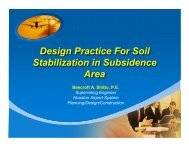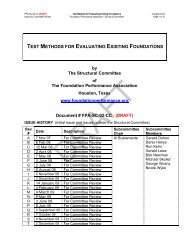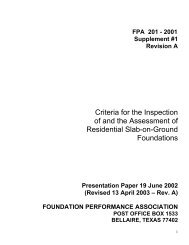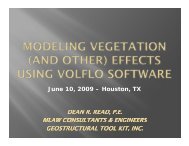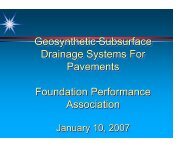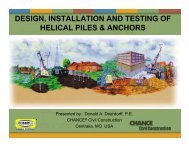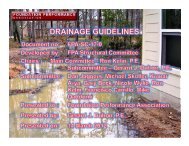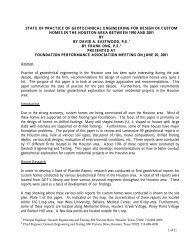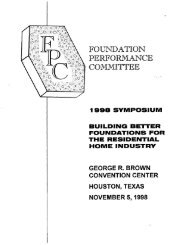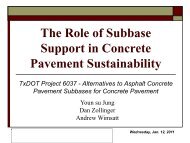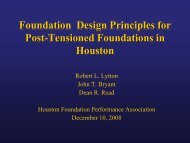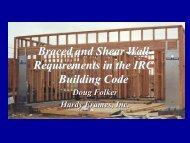Soil-Structure Interaction Seminar - Foundation Performance ...
Soil-Structure Interaction Seminar - Foundation Performance ...
Soil-Structure Interaction Seminar - Foundation Performance ...
Create successful ePaper yourself
Turn your PDF publications into a flip-book with our unique Google optimized e-Paper software.
Inspections<br />
Every homeowner should conduct a yearly observation of foundations and flatworks and perform<br />
any maintenance necessary to improve drainage and minimize infiltrations of water from rain and<br />
lawn watering. This is important especially during the first six years of a newly built home<br />
because this is usually the time of the most severe adjustment between the new construction and<br />
its environment.<br />
Some cracking may occur in the foundations. For example, most concrete slabs can develop<br />
• hairline cracks. This does not mean that the foundation has failed. All cracks should be<br />
cleaned up of debris as soon as possible. The cracks should be backfilled with high-strength<br />
epoxy glue or similar materials. If a foundation experiences significant separations, movements,<br />
cracking, the owner must contact the builder and the engineer to find out the reason(s) for the<br />
foundation distress and develop remedial measures to minimize foundation problems:-·<br />
General<br />
I<br />
FOUNDATION STABILIZATION<br />
Several methods of foundation stabilization are presented here. These recommendations include<br />
foundation underpinning, using drilled footings or jacked precast piles, moisture barriers,<br />
moisture stabilization, and chemical stabilization. Some of these methods are being used in the<br />
Houston area. A description of each method is summarized in the following sections of this<br />
document.<br />
<strong>Foundation</strong> Underpinning<br />
<strong>Foundation</strong> Underpinning, using drilled footings or precast driven piles has been used in the<br />
Houston area for a number of years. The construction of a drilled footing consists of drilling<br />
a shaft, about 12-inches in diameter (or larger) underneath a grade beam. The shaft is generally<br />
extended to depths ranging from 8 to 12-feet below existing grade. The bottom of the shaft is<br />
then reamed with an underreaming tool. The hole is then backfilled with steel, concrete, and<br />
the grade beams are jacked to a level position and shimmied to level the foundation system.<br />
In a case of jacked precast piers, precast concrete piers are driven into the soils. These pier<br />
attain there bearing capacity based on the end bearing and the skin friction. In general, the<br />
precast concrete piers are about 12-inches in height, six-inches in diameter and jacked into the<br />
soil. It is important the precast pier foundations are driven below the active zone to resist the<br />
uplift loads as a result of underlying expansive soils. Some of these jacked piles may consist of<br />
perma-piles, ultra piles, cable lock piles, etc.<br />
GEOTECH ENGINEERING AND TESTING, INC. -------------·<br />
22



